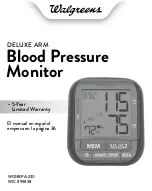
4
• Excessive use may result in blood flow interference, which is likely
to cause uncomfortable sensations, such as partial subcutaneous
hemorrhage, or temporary numbness to your arm. In general, these
symptoms should not last long. However, if symptoms persist, please
seek advice from a medical professional.
• The pulse display is not suitable for checking the frequency of heart
pacemakers.
• Electromagnetic interference: The device contains sensitive electronic
components. Avoid strong electrical or electromagnetic fields in the
direct vicinity of the device (ex. mobile telephones, microwave ovens).
These may lead to temporary impairment of measurement accuracy.
• Consider the electromagnetic compatibility of the device (ex. power
disturbance, radio frequency interference, etc.) Please use this device in
a home health care environment only.
• Use blood pressure monitor only for its intended use.
• DO NOT wrap the cuff around body parts other than your arm.
• DO NOT touch, move, or shake the device during a measurement as this
could cause an inaccurate blood pressure reading.
• DO NOT talk or move your arm or hand muscles during a measurement
as this could cause an inaccurate blood pressure reading.
• DO NOT use this device on infants, children, or those who cannot
express their own intention.
• Not for use by or on persons under the age of 18.
• Use only 1.5V “AAA” alkaline batteries for power supply.
• The patient is an intended operator.
• The applied part is the cuff.
• Blood pressure measurements determined with this device are
equivalent to those obtained by a trained observer using the cuff/
stethoscope auscultatory method, within the accuracy limits prescribed
by the American National Standard, manual, electronic, or automated
sphygmomanometers. The sphygmomanometer was clinically
investigated according to the requirement of ISO 81060-2: 2013.
Summary of Contents for 899838
Page 73: ...72 ...






































